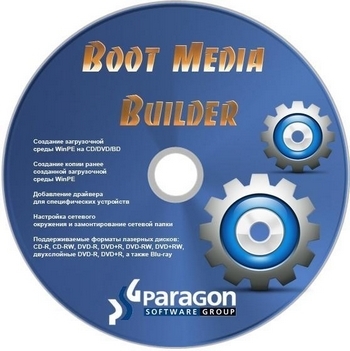

- #Paragon recovery media builder 3.0 install
- #Paragon recovery media builder 3.0 manual
- #Paragon recovery media builder 3.0 software
Paragon’s Migrate OS to SSD 4.0 told us to edit the boot order in the BIOS, which is a must if you have several drives – particularly if you leave the source drive in the system. The next step was physically replacing the drive inside the VivoPC (only one SATA port available), something that also happened to reduce this tiny device’s weight considerably. Since our source drive was an excellent candidate for testing due to its GPT+UEFI boot mode, we selected the other option as well, “Create new EFI boot entry for destination drive”.Īfter about 20 minutes, the process was complete.
#Paragon recovery media builder 3.0 software
The software might still create additional, small partitions required by the system though. You get the option to use all the available space on the new SSD for the OS partition, which is most likely what you intend to do.

#Paragon recovery media builder 3.0 install
Our system was a more or less fresh install of Windows 8.1, so the cloning procedure could get started right away. In other words: if you don’t plan on immediately using the source drive as a secondary or external drive, you are likely better off moving your files off the drive manually to avoid losing access to the excluded content. When your source drive uses up more space than the SSD can hold you are given the option to exclude certain space-consuming files such as photos and video. If the content of the source drive does not exceed the capacity of the target drive, the software goes right ahead with the cloning job. You simply choose a source and a destination.
#Paragon recovery media builder 3.0 manual
The same can certainly not be said for certain other alternatives, which tend to include USB boot drives and occasionally some manual labor with command-line tools. The interface is very simple and should be easy to use regardless of your previous drive-cloning experience. Installing Paragon Migrate OS to SSD 4.0 (64-bit version) was a hassle-free experience. Although a low-end system, it should become considerably more responsive after moving it to a 120 GB Intel 530 SSD using an external USB 3.0 adapter. Migrate OS to SSD has now reached version 4.0.įor testing the software we used a low-end ASUS VivoPC with a Celeron 2957U processor running at just 1.4 GHz, combined with a noisy, hot and painfully slow 500 GB 3.5” hard drive. We have successfully used a previous version of this software for moving our test system from drive to drive, but it didn’t support Windows 8.1 so it was due for an upgrade. Without going into detail about these acronyms, they can render a newly cloned drive unbootable.Īs the name implies, Paragon Software’s Migrate OS to SSD is specifically developed for moving your stuff to an SSD, while also solving the above limitations it lets you downsize partitions and also handles GPT-associated issues. Another potential problem is when your source drive uses the newer GPT (GUID Partition Table) + UEFI boot mode instead of the old MBR (Master Boot Record) standard. It’s quite common that cloning solutions fall short in some areas, such as being able to convert a larger partition to a smaller one, which is often the case with SSDs due to the significantly higher cost per GB. Moreover, there are no guarantees that the bundled software actually works. Several manufacturers include cloning software in the box (or a key to a downloadable version) when you buy a new drive, but you don’t always have this option. There are several alternatives available that will move your OS to a new location, e.g. When using links on our site to make a purchase, we may earn an affiliate commission.


 0 kommentar(er)
0 kommentar(er)
